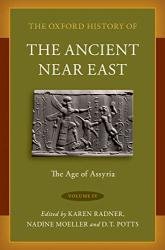The Oxford History of the Ancient Near East: Volume IV: The Age of Assyria
- Добавил: literator
- Дата: 23-03-2023, 04:03
- Комментариев: 0
 Название: The Oxford History of the Ancient Near East: Volume IV: The Age of Assyria
Название: The Oxford History of the Ancient Near East: Volume IV: The Age of AssyriaАвтор: Karen Radner, D. T. Potts, Nadine Moeller
Издательство: Oxford University Press
Год: 2023
Страниц: 1288
Язык: английский
Формат: epub (true)
Размер: 89.1 MB
This groundbreaking, five-volume series offers a comprehensive, fully illustrated history of Egypt and Western Asia (the Levant, Anatolia, Mesopotamia, and Iran), from the emergence of complex states to the conquest of Alexander the Great. Written by a diverse, international team of leading scholars whose expertise brings to life the people, places, and times of the remote past, the volumes in this series focus firmly on the political and social histories of the states and communities of the ancient Near East. Individual chapters present the key textual and material sources underpinning the historical reconstruction, paying particular attention to the most recent archaeological finds and their impact on our historical understanding of the periods surveyed.
The fourth volume of the Oxford History of the Ancient Near East covers the period from the end of the second to the middle of the first millennium BC, ca. 1100-600 BC, corresponding with Egypt's "Third Intermediate Period". Fifteen chapters present the history of the Near East during "The Age of Assyria," from the formative period of the Assyrian Empire to this influential state's disintegration. Several of the chapters discuss the challenges of reconstructing the sequence of local rulers and the various sources and diverse strategies harnessed in order to overcome these difficulties, notably for Egypt, for Elam, for Urartu and on northern Syria and southeastern Anatolia. This volume offers new and complementary perspectives on the history of northeastern Africa, the eastern Mediterranean, and the Middle East from the 11th to the 7th century BC.
In Egypt, this corresponds to the so-called Third Intermediate Period (chapter 35), when the lands on the Nile were rarely united and frequently under the control of external rulers, most importantly members of the Nubian royal house of Napata (chapter 36). Egypt’s fate broadly matched the historical trajectory of Babylonia (chapter 41), in which the Assyrian Empire and the southwest Iranian kingdom of Elam (chapter 42) often influenced and sometimes dominated local politics. While this period witnessed the emergence of the state of Mannea in northwestern Iran (chapter 43), the mountain kingdom of Urartu (chapter 44) further north, in northwestern Iran, Armenia, and eastern Anatolia, was Assyria’s most serious rival. Further to the west, in central and western Anatolia, a mosaic of small states positioned themselves as the heirs of the Hittite Empire (chapter 46), with the kingdom of Phrygia gaining control over the former imperial heartland (chapter 45). This was also the time when some of the city-states on the Phoenician coast launched their fleets across the Mediterranean Sea to found colonies as far away as the Atlantic coast (chapter 47), and when the kingdoms of Israel and Judah flourished (chapter 48). All of these states were affected to varying degrees by the expansion of the Assyrian Empire, especially from the mid-eighth century bc onward, and also by its collapse, a process hastened by the armies of the newly constituted kingdoms of Babylon (chapter 50 in volume 5) and Media (chapter 43). The volume charts the fate of these regions down to the disintegration of the Assyrian Empire.
Assyria dominates this volume also in terms of the chronological reconstructions attempted by modern scholars. Ultimately, all local chronologies, even those of Egypt and Kush, are dependent on synchronisms with Assyria where king lists and eponym lists (which record the sequence of the high-ranking individuals that had the privilege to lend their names to a given year) exist that can be absolutely dated due to the fact that a solar eclipse of 763 bc has been recorded. Several of the chapters in the present volume discuss the challenges of reconstructing the sequence of local rulers and the various sources and diverse strategies harnessed in order to overcome these difficulties, notably chapter 35 for Egypt, chapter 42 for Elam, chapter 44 for Urartu, and chapter 46 on northern Syria and Central Anatolia. The following Time Chart presents a concise overview of the chronological coverage of this volume, focusing on the most important states. The chart also includes the sequence of the kings of Israel and Judah, who will be familiar to many readers from the Bible, although their contemporary influence was far more limited than that of the Assyrian, Babylonian, Urartian, and Egyptian rulers recorded in the chart. The chart’s later parts should be consulted together with the Time Chart given in the fifth volume of the Oxford History of the Ancient Near East, as there is some chronological overlap.
Скачать The Oxford History of the Ancient Near East: Volume IV: The Age of Assyria
[related-news] [/related-news]
Внимание
Уважаемый посетитель, Вы зашли на сайт как незарегистрированный пользователь.
Мы рекомендуем Вам зарегистрироваться либо войти на сайт под своим именем.
Уважаемый посетитель, Вы зашли на сайт как незарегистрированный пользователь.
Мы рекомендуем Вам зарегистрироваться либо войти на сайт под своим именем.
